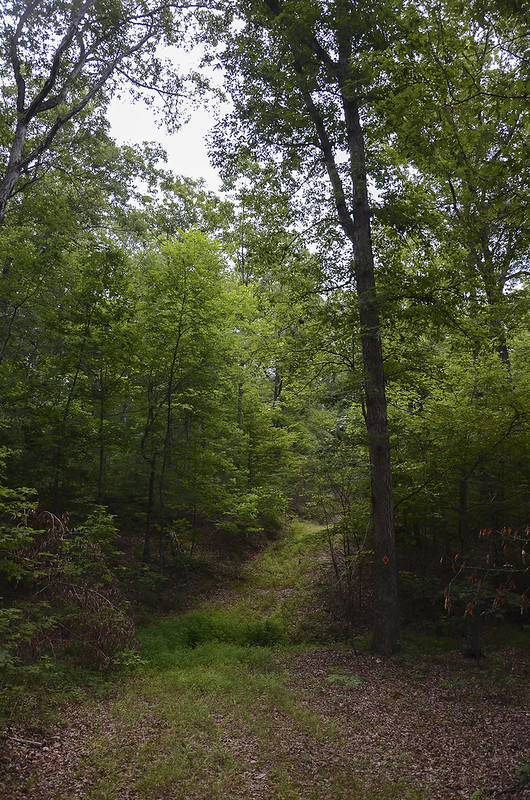 There are plenty of small streams the cut through the dunes and empty into Lake Michigan, and we manage to find most of them! This particular one formed a small marsh just before it entered Lake Michigan, making it a fun area for the boys to explore. Probably due to the beachgoers, not many creatures were hanging around the marsh on this morning, but we did come across plenty of dragonflies. Soon, the weather will begin to turn cold, and crossing these small streams will not be as easy - at least, not as comfortable - as it is in the summer months.
There are plenty of small streams the cut through the dunes and empty into Lake Michigan, and we manage to find most of them! This particular one formed a small marsh just before it entered Lake Michigan, making it a fun area for the boys to explore. Probably due to the beachgoers, not many creatures were hanging around the marsh on this morning, but we did come across plenty of dragonflies. Soon, the weather will begin to turn cold, and crossing these small streams will not be as easy - at least, not as comfortable - as it is in the summer months.
Exploring the Marsh
 There are plenty of small streams the cut through the dunes and empty into Lake Michigan, and we manage to find most of them! This particular one formed a small marsh just before it entered Lake Michigan, making it a fun area for the boys to explore. Probably due to the beachgoers, not many creatures were hanging around the marsh on this morning, but we did come across plenty of dragonflies. Soon, the weather will begin to turn cold, and crossing these small streams will not be as easy - at least, not as comfortable - as it is in the summer months.
There are plenty of small streams the cut through the dunes and empty into Lake Michigan, and we manage to find most of them! This particular one formed a small marsh just before it entered Lake Michigan, making it a fun area for the boys to explore. Probably due to the beachgoers, not many creatures were hanging around the marsh on this morning, but we did come across plenty of dragonflies. Soon, the weather will begin to turn cold, and crossing these small streams will not be as easy - at least, not as comfortable - as it is in the summer months.
Sunset Plunge
 Taking advantage of the last weekend before school, the boys swam in the lake until dark. Nothing unusual for them - they tend to swim all day anyway, but this week seemed different. The weather turned rainy during dinner, but cooperated and stopped in time for them to enjoy the lake for a few more hours. Sunset itself wasn't too spectacular, but as the sun dropped below the horizon, the clouds broke up and displayed some beautiful golden colors against the dark blue sky. I've found this to be the case numerous times when disappointed by the sunset, stick around for 30 minutes, sometimes the sky is more amazing after sunset. With any luck, we'll repeat this scene a few times during the next few weeks.
Taking advantage of the last weekend before school, the boys swam in the lake until dark. Nothing unusual for them - they tend to swim all day anyway, but this week seemed different. The weather turned rainy during dinner, but cooperated and stopped in time for them to enjoy the lake for a few more hours. Sunset itself wasn't too spectacular, but as the sun dropped below the horizon, the clouds broke up and displayed some beautiful golden colors against the dark blue sky. I've found this to be the case numerous times when disappointed by the sunset, stick around for 30 minutes, sometimes the sky is more amazing after sunset. With any luck, we'll repeat this scene a few times during the next few weeks.
Just Past the Golden Hour

It's said that one of the best times for photography is the "golden hour," an hour just before sunset. I've found this to be true, but I've also found that the minutes just after sunset can create striking images as well. Using the golden hour, generally the sun is behind the camera, illuminating the subject in golden light. This image was shot into the light created by a colorful sunset after a storm moved through the area. No color enhancing in this image, they sky was on fire. The fun certainly doesn't end at sunset. The boys enjoyed a summer day swimming in the lake until a storm rolled in at dinner time. After a meal and dessert the rain ended, allowing them to get back in the water until dark. School is in session again, but summer isn't over yet.
Wetland from the Dune Ridge

An easy hike up from the trail head on a normal day, this turned into a workout in the heat and humidity. No complaints here.
3/4 of the way to the ridge, we were greeted by several Cicada Killer wasps - huge wasps that hunt cicadas in mid flight, then return with them to their burrows to feed their larvae. They're quite intimidating, but if you realize the ones that seem to fly at you are male and have no stinger, you allow them to fly toward you. The larger female can sting, but is timid, and usually won't bother. They're about the size of an adult's thumb.

After several minutes watching the wasps battle for territory, we headed up to the ridge of the dune for a great view of the wetlands below. In summer, the view is mostly shielded by green leaves, but in winter when the leaves are gone, you have a wider view of the area.
Also found along this trail are six lined racerunner lizards - in fact, at times you can see half a dozen in a few yards. These lizards are found in many locations within the Indiana Dunes National Lakeshore.

Peaceful Now

The battlefield where Confederate General Bragg completed his "Kentucky Invasion" is now quiet. On this site in October 8, 1862, 1,355 men were killed, and over 5,000 were injured fighting for control over this piece of land.
It's difficult to walk through this rolling countryside without sensing the battle that took place here. The thousands killed and injured, the artillary pounding the front line, the chaos, and the incredible noise.
Peaceful now.
Shady Acres

On our visit to Munfordville, I stopped to walk around a rustic barn on the Anthony Woodson Farm. Like hundreds of other barns I've seen in the countryside, this one is still structurally sound, but the weathered siding hints at its age.
The short time on this farm made me think of all the barns once utilized in this part of Kentucky - especially tobacco barns. I remember just 25 or 30 years ago, seeing field after field of tobacco on my drive to Mammoth Cave, each had a rustic tobacco barn on the property. Now, I struggle to find a single tobacco field in this area.
The barns in the midsection of the country are slowly fading away, and crumbling - no longer needed, or replaced by uninteresting steel-sided boxes.
Battlefield to Hay Field, Munfordsville, Kentucky
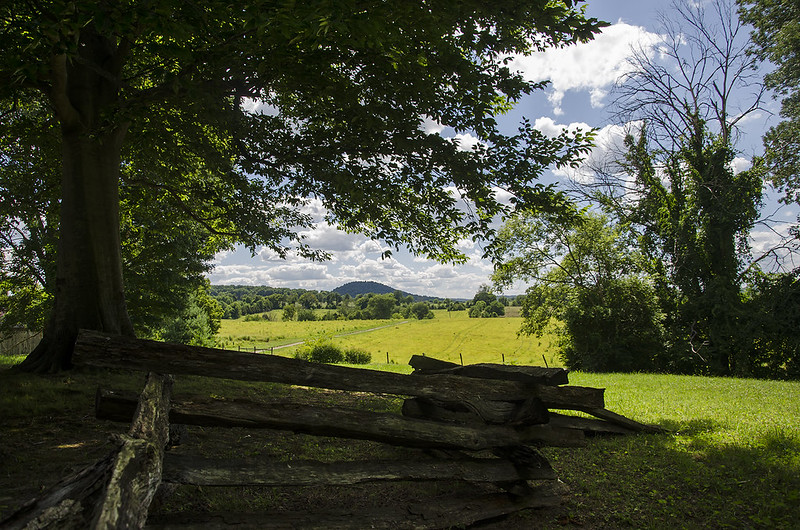
Our interest in the American Civil War brings us to plenty of historic places, and one of the lesser known favorites of ours is Munfordville, Kentucky. A city of 1,600 people, Munfordville is the county seat of Hart County.

A stop along the Louisville and Nashville Railroad, and the site of railroad bridge crossing the Green River, Munfordville was an important route for Union supplies heading south. Confederate General Bragg's army arrived in Munfordville on September 14th, 1862, and demanded surrender of the Union forces dug in at Fort Craig, a small fort about 1000 yards from the railroad bridge.

A battle ensued for control of the bridge over the Green River. Union forces were well positioned, but did not anticipate their exposure on the opposite bank of the Green River, and the Confederates took advantage.
Even though it was a small battle, the battle flag of the 67th Indiana Infantry had 146 bullet holes in it following the fighting. After three days of fighting, the casualties totaled 4,862 - Union 4,148; Confederate 714. On September 17th, Col. John Wilder surrendered to avoid unnecessary civilian casualties. This important transportation point was now under Confederate control, hampering the movement of Union supplies.

Trains still cross the Green River on the same bridge today, and the battlefield is an historic preserve open to the public. The site of Fort Craig can be seen next to the battlefield, now only the earthen mounds are present, as the wood from the fort was used as firewood after the war.
Adjacent to the fort is the Green River Church Cemetery, a small graveyard overlooking the rolling hills, Green River, and railroad bridge.

Just across the River in Munfordville proper, is the Green River Park and Arboretum. This quiet city park includes a small loop hiking trail, boat ramp, playground, canoe rental, and views of the Green River. It's also the site of the Big Buffalo Crossing, memorialized by a life size buffalo statue which children enjoy. It provides a green backdrop to a relaxing walk under the 31W bridge.

The trailhead for the 4.5 mile Jenny Wilson Byrd Memorial Trail is at the eastern end of the park.

This trail follows the bank of the Green River, and is the trail we'll explore next time we visit the area. Just a few feet from the trailhead is the old pump tower. Built in 1915, this tower elevated river water to town level, providing water for Munfordville. It stands today as a piece of local history.

Downtown Munfordville offers small town charm, including eating establishments, and shops along a strip of historic storefronts. Of particular interest is the old Coca Cola sign, painted on the side of a business. Most likely a repaint, but really makes you think of times gone by.

Kentucky Knob
Set aside in 2006, this 1500 acre reserve in Bullitt County, Kentucky gives visitors a chance to see these wooded knobs from ground to ridge. Four interconnecting trails totalling a bit over 6.5 miles meander up and down the knobs, allowing visitors to view most of the forest. The trails seem to be former logging roads, about 8 feet wide and packed down where tires once rolled. They are, at times, covered in knee-high groundcover, but well defined for the most part, with the exception of a few places that had us guessing the correct route.
The difficulty was mostly moderate as the trails headed up and down the landscape, but strenuous at times depending upon the rise in elevation - especially reaching the top of the knobs at the end of the 2.5 mile long trail.
Our day began at 4 am, when Chris and I headed to the car while everyone else slept. We drove the easy 25 miles to the tiny gravel parking lot about 100 feet off of Crooked Creek Road. Unsure at first, I passed it up, but later found that we had to drive through Crooked Creek to get to the parking lot. On this day the creek was dry, allowing us easy access to the parking lot.
Ready for our battle with insects, we brought along plenty of deet, long sleeves and long pants, and a roll of black duct tape. Not wanting to deal with ticks, I taped the bottoms of our pants to our boots to prevent ticks from crawling up onto our legs. (a much better option than tucking the pants into socks as most hiking websites suggest) I also taped my pockets to prevent my car keys from slipping out during the hike. The tape worked very well in both cases, especially with the ticks, we each had only one tick on the outside of our jeans on the entire 6 mile hike. Spiders, however, were plentiful - very plentiful, and attached themselves to my shirt and head dozens of times during the hike, as I broke through their large webs.
As we set out, the sun had not risen, yet a bit of light was evident in the sky, allowing us to see the trails well enough in the thick woods. One only two occasions we questioned the route. Generally well marked with colored diamond labels on select trees, the trails intersected at times, making us stop and search for the correct trail. And what we thought was the end of the orange trail, was only a turn up to the top of the knob - a steep ascent with no apparent trail markings or flattened foliage. Our best guess turned out correct as we spotted a few orange diamonds on trees ahead of us.
Well worth the strenuous climb to the top of the knob (at 941 feet), we were rewarded with an interesting landscape as well as a few small spots offering excellent views of the rolling countryside. I can only imagine how the view is during the winter and early spring before the leaves fill the trees.
Disappointed we weren't able to stay longer, we soaked in the views, and the unusual silence of this place. What amazed me is the quiet we experienced with I-65 only a mile or two away; we heard absolutely nothing. Of particular interest was the narrow ridge of the knob. The trees seemed to lean away from the top, giving us the feeling we were walking on top of the forest.
For a few seconds, we lost the way down to the trail from the ridge. This portion of the trail had no matted down or worn down areas, so it blended in perfectly with the rest of the forest floor. We knew the only view we had was on our left as we climbed, so we proceeded to slide down the hillside with the view to our right. Sure enough, we spotted the orange diamond on a tree behind us, and a few minutes later, we connected back at the well defined portion of the trail. Our walk back was at a faster rate, but a bit strenuous in spots, probably due to the climb previous.
It was certainly worth waking up early to walk through this part of Kentucky, a part that most visitors don't see, and a part that I finally experienced after years of wonder. Back to the hotel to celebrate with an ice cold Ale 8 1, a soda manufactured in Kentucky since 1926.
Rolling Through Lemont

A Burlington Northern and Santa Fe freight train rolls over the Sanitary and Ship Canal on the Lemont Railroad Bridge. Constructed in 1898 by the Keystone Bridge Company of Pittsburgh, the steel swing bridge has a span of 375 feet, and is frequently used by the railroad. During our 30 minute walk, three trains passed over this bridge.

In Lemont for the weekly Lemont Ledgends cruise night, we often explore the area after viewing the custom and vintage cars parked up and down the downtown streets. This time, we decided to to hike over the Lemont Ave bridge to view the I and M Canal, Sanitary and Ship Canal and the DesPlains River - all within a block or so of each other, and the downtown area. Used heavily for industry, the Sanitary and Ship Canal is filled with tugboats and barges, but offers few places for viewing other than bridges.
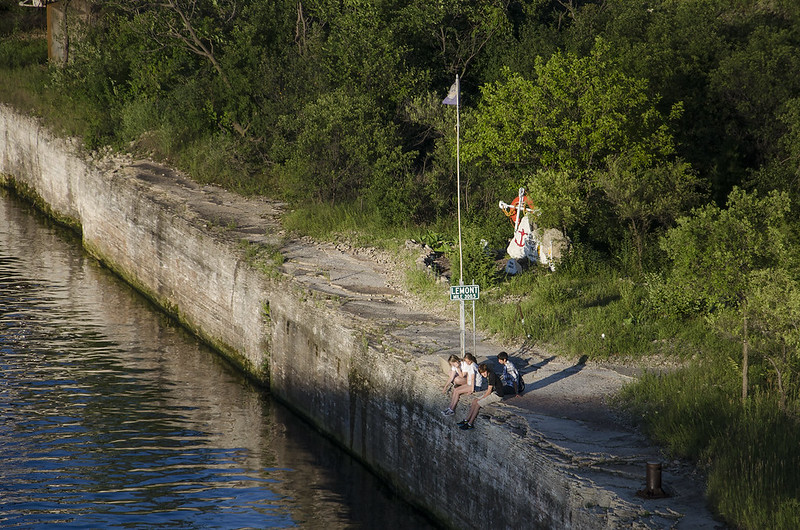
As we approached the top of the bridge, over the canals, we noticed a small area on the bank of the canal with some sort of a stone memorial, and a few teenagers sitting near it. Figuring it must be a small acess point, we made our way back downtown to find it.

In short order, we discovered a narrow path that led from a side street to the bank of the canal. The memorial we saw from the bridge, honored mariners of the Illinois Marine Towing company, a local frieght company. Perhaps this small landing is a place for the deckhands to stop for a break, or a walk to town.
Either way, it offered a view of the canal traffic, as well as a safe place to watch traffic on the railroad bridge.
Stately Dilapidation
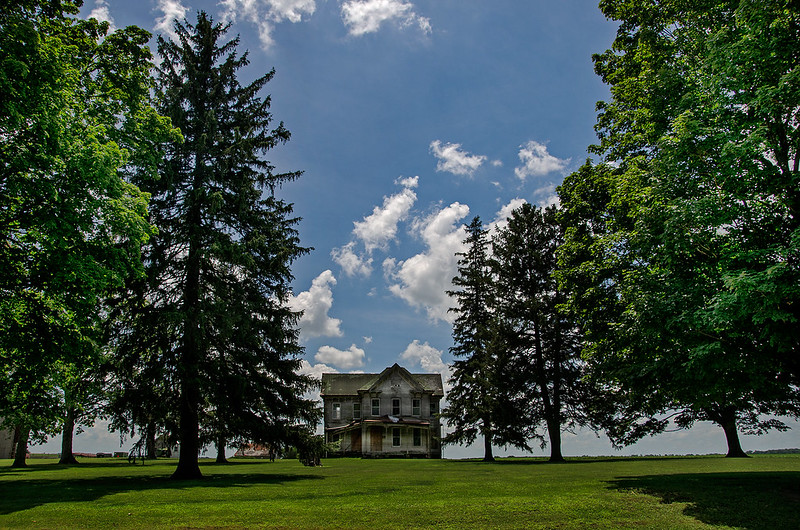
On our journey down old Route 66, south of Bloomington Normal, we found ourselves wandering off the route after missing an unmarked turn. Instead of doubling back a mile or so, we took a detour down a small road that eventually connected to Route 66.
This stately farmhouse, seemingly unoccupied for many years, has seen better days, yet the grounds were manicured beautifully. The tall trees framed the home when viewed from the road, inviting us to take a closer look.
Taking it Slow

On our drive down the old Route 66, we came across the tiny town of Funk's Grove, Illinois. We didn't see a downtown, a business district, or anything actually, yet as we followed a small road that intersected Route 66, we came across a very well manicured and maintained small church, cemetery and nature preserve. The Sugar Grove Nature Center is free, and open year-round from dawn to dusk. There are several well marked trails that wind through Illinois' largest intact prairie grove, a small nature center, barn, firepit, and friendly staff.
One trail leads hikers about a mile to the Funk's Grove Church and Cemetery, and the Chapel in the Trees, an outdoor church with huge logs acting as pews and lecterns.
Hiking through the dense, damp woods, we came upon several interesting snails making their way toward shade and food. This one wandered into a small dab of sunlight at the perfect moment.
Late Afternoon at the Dwight Windmill

No trip down Route 66 would be complete without a stop at the Dwight Windmill, in the small town of Dwight, Illinois. Not really a purist Route 66 stop, but we take the half mile or so detour to visit each time we pass.
Built in 1896 as the source of water for the Oughton Estate, the windmill was constructed by U.S. Wind, Engine, and Pump Company of Batavia, Illinois. It originally housed an 88 barrel tank near the top which held the water pumped from a depth of 840 feet below ground.
The windmill is in beautiful condition, owned by the Village of Dwight, and is open to the public.
Bend in the Mighty Mississippi
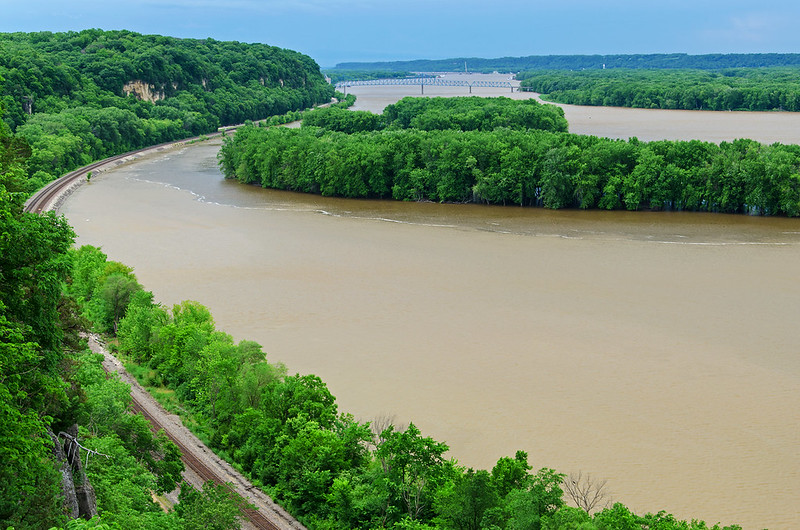 Following a rainy drive from central Illinois, we arrived at the Mississippi Palisades State Park in rather nice weather. Thunderstorms surrounded us, but never rained on us the rest of the day. The sky is a bit threatening in the distance, southeast of Savanna, Illinois - the self proclaimed "Sportsman's Paradise" on the Mississippi River. I do imagine if you're a fisherman, this is a place you'll enjoy; so many secluded inlets on the river, it would take years to explore them all. The first time we visited the Mississippi Palisades, we parked near a trail head, and hiked the trail to the observation deck, about 1/2 mile through thick, hilly forest, only to realize we could have driven to the deck and only walked 100 feet! I'd rather hike while I'm still able, but knowing about the other parking area sure makes things easy. We've taken a few of the other trails as well, and they get pretty dense - so much so that we couldn't tell if we were still on the trail or on an animal trail. Great for exploration, but watch out for ticks and mosquitoes. While the views in this park seem limited to the wooded banks of the Mississippi, and the Burlington Northern/Santa Fe railroad tracks, it's certainly a beautiful view, and worth taking in. Going to have to make this trip in the winter, when the river is frozen, and the woods are snow covered.
Following a rainy drive from central Illinois, we arrived at the Mississippi Palisades State Park in rather nice weather. Thunderstorms surrounded us, but never rained on us the rest of the day. The sky is a bit threatening in the distance, southeast of Savanna, Illinois - the self proclaimed "Sportsman's Paradise" on the Mississippi River. I do imagine if you're a fisherman, this is a place you'll enjoy; so many secluded inlets on the river, it would take years to explore them all. The first time we visited the Mississippi Palisades, we parked near a trail head, and hiked the trail to the observation deck, about 1/2 mile through thick, hilly forest, only to realize we could have driven to the deck and only walked 100 feet! I'd rather hike while I'm still able, but knowing about the other parking area sure makes things easy. We've taken a few of the other trails as well, and they get pretty dense - so much so that we couldn't tell if we were still on the trail or on an animal trail. Great for exploration, but watch out for ticks and mosquitoes. While the views in this park seem limited to the wooded banks of the Mississippi, and the Burlington Northern/Santa Fe railroad tracks, it's certainly a beautiful view, and worth taking in. Going to have to make this trip in the winter, when the river is frozen, and the woods are snow covered.
Storm Cell
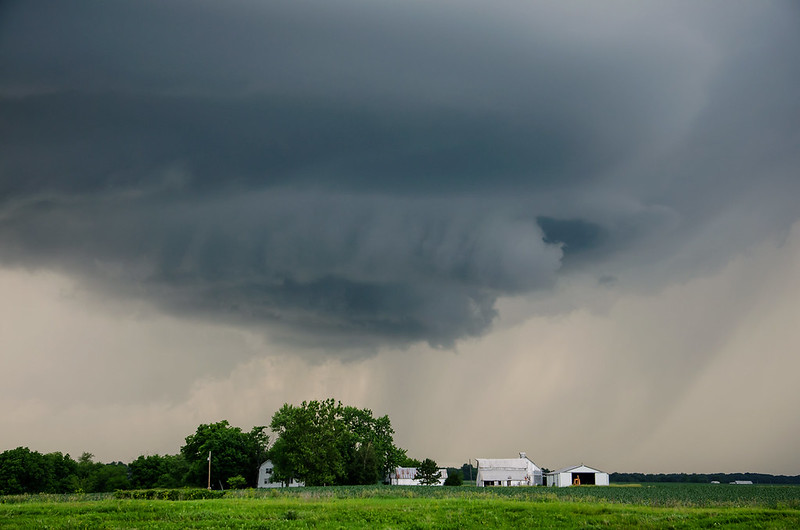
On our return trip from the Mississippi River, we noticed a storm cell forming to the north of us. It quickly developed into an interesting formation, and began dumping rain on the Illinois countryside. This cell seemed very localized, even though storms surrounded us the whole day, but it only rained on us as we drove to our second stop. Closer to home, we encountered a much larger and more intense storm, with cloud to ground lightning every few seconds, and heavy rain. Too bad it was night, and we were driving, otherwise we could have set up for some excellent lightning images.
Blackwater
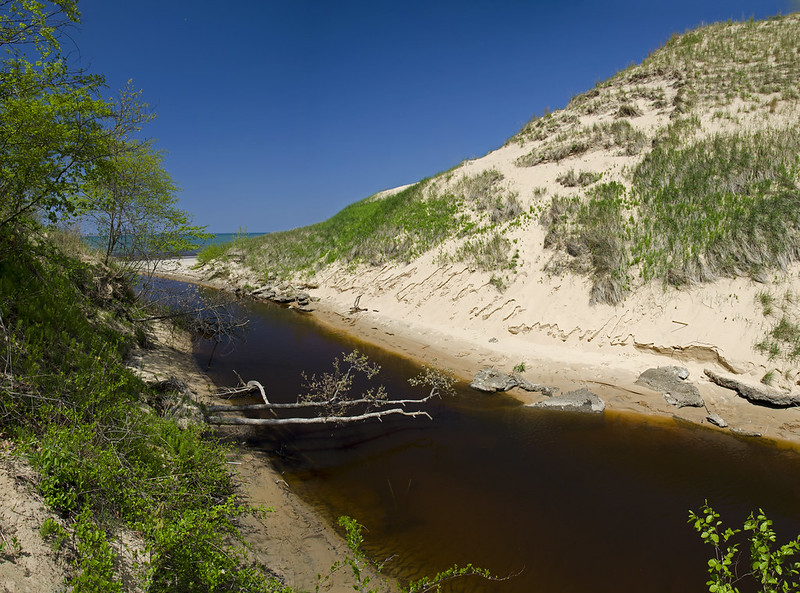 As kintzele Ditch flows through the wooded areas of the Indiana Dunes National Lakeshore, it picks up tannins from the vegetation, turning the water a deep, tea color. This is sometimes known as Blackwater. On this day, the waters provided a strong contrast to the surrounding sand dunes - especially in the bright sunlight. A favorite destination of ours, Kintzele Ditch is a short walk from Central Beach and Mt. Baldy (now closed due to last year's sinkholes). The stream is ever changing, due to the wind, and waves of Lake Michigan; sometimes the mouth of the stream changes by hundreds of feet. On days when Lake Michigan is calm, the lack of waves allows the stream to empty easily into the lake, and the tannin rich water is evident along the shore until it mixes with Lake Michigan.
As kintzele Ditch flows through the wooded areas of the Indiana Dunes National Lakeshore, it picks up tannins from the vegetation, turning the water a deep, tea color. This is sometimes known as Blackwater. On this day, the waters provided a strong contrast to the surrounding sand dunes - especially in the bright sunlight. A favorite destination of ours, Kintzele Ditch is a short walk from Central Beach and Mt. Baldy (now closed due to last year's sinkholes). The stream is ever changing, due to the wind, and waves of Lake Michigan; sometimes the mouth of the stream changes by hundreds of feet. On days when Lake Michigan is calm, the lack of waves allows the stream to empty easily into the lake, and the tannin rich water is evident along the shore until it mixes with Lake Michigan.
Chicago Harbor Light
 Built in 1893, the Chicago Harbor Light marks the entrance to the Chicago River - a waterway once vital to the Midwest. Today, the river supports mainly pleasure boaters and tours, and it's difficult to imagine industry and shipping filling the lake and river. In 1871, an attempt was made to reverse the flow of the Chicago River, so the city's sewage and waste would not flow into Lake Michigan - Chicago's source of drinking water. The reversal was made permanent when a series of locks and dams were constructed in 1900 along with the Sanitary and Ship Canal system. Today, a single lock stands between Lake Michigan and the Chicago River, just south of Navy Pier. If you're on the river, in the lock, you can watch the gates open slowly, and the water from Lake Michigan pour into the lock to equalize the river and lake levels. Once the gates fully open, the Chicago Harbor Light comes into view. The lighthouse was automated in 1979, has a third order Fresnel lens, and is constructed of concrete and cast iron.
Built in 1893, the Chicago Harbor Light marks the entrance to the Chicago River - a waterway once vital to the Midwest. Today, the river supports mainly pleasure boaters and tours, and it's difficult to imagine industry and shipping filling the lake and river. In 1871, an attempt was made to reverse the flow of the Chicago River, so the city's sewage and waste would not flow into Lake Michigan - Chicago's source of drinking water. The reversal was made permanent when a series of locks and dams were constructed in 1900 along with the Sanitary and Ship Canal system. Today, a single lock stands between Lake Michigan and the Chicago River, just south of Navy Pier. If you're on the river, in the lock, you can watch the gates open slowly, and the water from Lake Michigan pour into the lock to equalize the river and lake levels. Once the gates fully open, the Chicago Harbor Light comes into view. The lighthouse was automated in 1979, has a third order Fresnel lens, and is constructed of concrete and cast iron.
Rain on its Way
 Our voyage down the Chicago River was calm and relaxing. Aware of the threat of rain later in the day, we headed out on Lake Michigan. Once in open water, we felt the three foot waves created by the storm system a few miles west of the city. On our return trip to the river, the sky grew dark, the winds picked up, and we knew the rains were on their way. Just a few minutes after this photo, the Willis tower (I still call it the Sears Tower) disappeared - obscured by heavy rain. I told the kids I was reponsible for to come with me to the lower deck, to prepare to head inside. Moments later, the shoreline was engulfed in rain, and impossible to see; we headed below to the bar area. Seconds later, the rains hit, and all of the passengers raced to get inside - not sure why they didn't head in earlier. The bar area was packed with kids, all trying to stay dry. The winds gusted, the rain pelted the glass, and the waves crashed onto the deck and tossed the boat around a bit. Nothing huge, but each time the boat rocked, the kids screamed -not necessarily in terror, but as if they were riding a roller coaster. Some children commented that this is what it must be like aboard one of the fishing boats on Deadliest Catch (only if we were awake for 4 days, it was 70 degrees colder, had more wind, and the waves were ten times as high). The calm and prepared crew asked the children to stop screaming and to sit down on the deck so they wouldn't fall when the boat rocked. About 10 minutes later, we arrived at the Chicago River lock and the waters instantly calmed, and so did the storm. Our return to the dock was pleasant, and dry. So many of the children commented that this was the best field trip ever! A ride on a boat with a tour Chicago, and a storm at the end that tossed the boat around Lake Michigan - a great story to tell indeed.
Our voyage down the Chicago River was calm and relaxing. Aware of the threat of rain later in the day, we headed out on Lake Michigan. Once in open water, we felt the three foot waves created by the storm system a few miles west of the city. On our return trip to the river, the sky grew dark, the winds picked up, and we knew the rains were on their way. Just a few minutes after this photo, the Willis tower (I still call it the Sears Tower) disappeared - obscured by heavy rain. I told the kids I was reponsible for to come with me to the lower deck, to prepare to head inside. Moments later, the shoreline was engulfed in rain, and impossible to see; we headed below to the bar area. Seconds later, the rains hit, and all of the passengers raced to get inside - not sure why they didn't head in earlier. The bar area was packed with kids, all trying to stay dry. The winds gusted, the rain pelted the glass, and the waves crashed onto the deck and tossed the boat around a bit. Nothing huge, but each time the boat rocked, the kids screamed -not necessarily in terror, but as if they were riding a roller coaster. Some children commented that this is what it must be like aboard one of the fishing boats on Deadliest Catch (only if we were awake for 4 days, it was 70 degrees colder, had more wind, and the waves were ten times as high). The calm and prepared crew asked the children to stop screaming and to sit down on the deck so they wouldn't fall when the boat rocked. About 10 minutes later, we arrived at the Chicago River lock and the waters instantly calmed, and so did the storm. Our return to the dock was pleasant, and dry. So many of the children commented that this was the best field trip ever! A ride on a boat with a tour Chicago, and a storm at the end that tossed the boat around Lake Michigan - a great story to tell indeed.
Timid
 In honor of World Turtle Day, 2014. While walking around the yard, the boys discovered a small, Spiny Softshell turtle walking near the road, quite a distance from water. Realizing he was going to get run over or eaten by a preditor, we carried him safely in the direction he was heading, to the lake and released him. Three of them could fit in the palm of a 10 year old's hand. A few more images of turtles here from the past few years:
In honor of World Turtle Day, 2014. While walking around the yard, the boys discovered a small, Spiny Softshell turtle walking near the road, quite a distance from water. Realizing he was going to get run over or eaten by a preditor, we carried him safely in the direction he was heading, to the lake and released him. Three of them could fit in the palm of a 10 year old's hand. A few more images of turtles here from the past few years: 
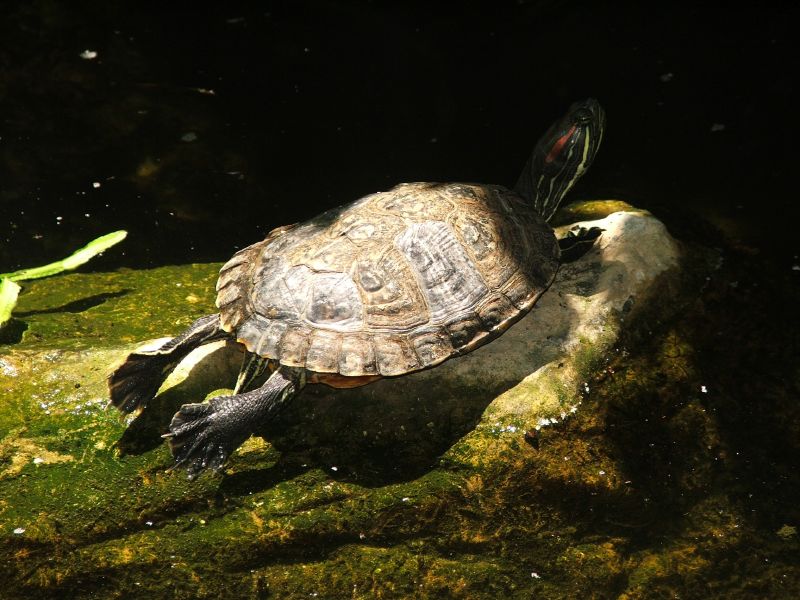
 Happy World Turtle Day.
Happy World Turtle Day.
Calling
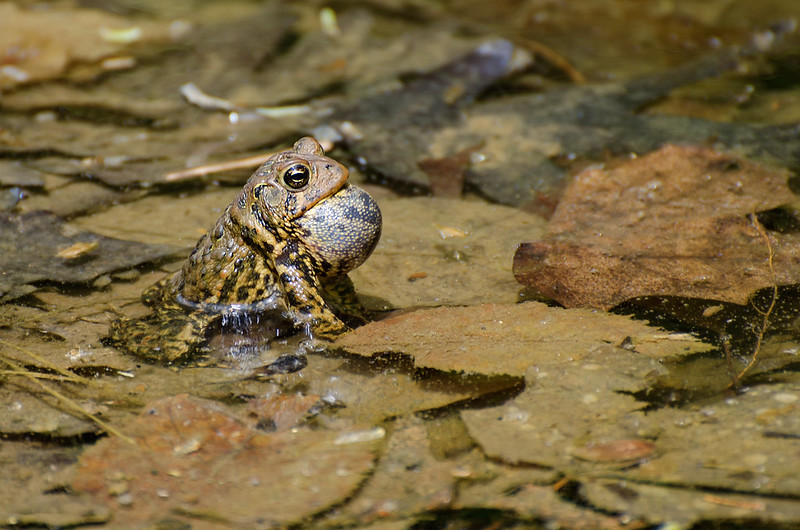 The call of large groups of frogs is one of the first real signs of Spring around this part of Illinois. Usually, as I walk by ponds and streams, the shy frogs quiet down, and hide, but this time, I decided to wait a bit for them to get used to me. After a few minutes, the frogs came out of hiding, and a bit later, one began to call for a mate. I could tell he was up to something, since he was sitting more upright than usual.
The call of large groups of frogs is one of the first real signs of Spring around this part of Illinois. Usually, as I walk by ponds and streams, the shy frogs quiet down, and hide, but this time, I decided to wait a bit for them to get used to me. After a few minutes, the frogs came out of hiding, and a bit later, one began to call for a mate. I could tell he was up to something, since he was sitting more upright than usual.If you look closely where the water meets the body of the frog, you'll see ripples in the water. These were caused by the vibration of the frog as he called. His vocal sac is displayed and in use - he wasn't bothered too much by my camera, and continued his search for a mate. Most of the other frogs in the small pond in Illinois Canyon already had mates, and were paired up in the water, oblivious to me.
Unfolding

Each Spring, I visit some of the wetlands of the Indiana Dunes National Lakeshore in search of plants and animals. Of particular interest are ferns; more specifically, fiddleheads. Before the fern fronds appear, they develop in a circular roll, and slowly unroll to form a frond. These rolled up fronds are called fiddleheads, and look similar to their namesake, although I assume, the end of a violin was patterned after the fern.
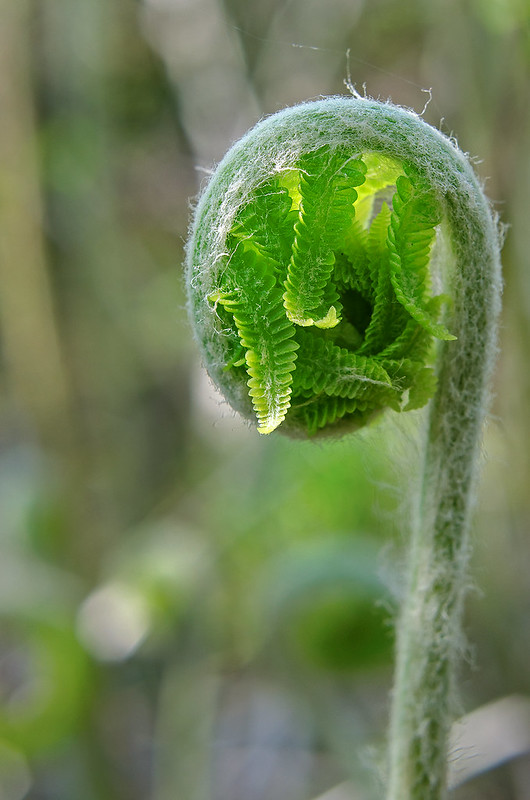
No two are exactly the same, and they don't stay rolled up for very long. What amazes me is that each of the tiny leaves of the fern is an almost exact match to the unrolled fern frond. So, the fern is comprised of fronds that are comprised of fronds. Look closely and you'll see what I mean. A sure sign that winter is over.
Subscribe to:
Comments (Atom)


